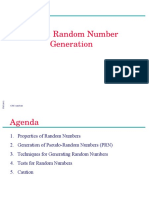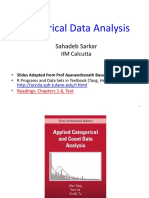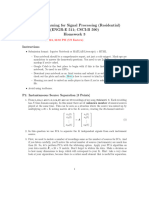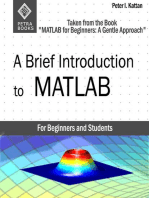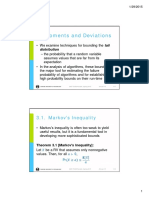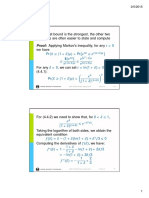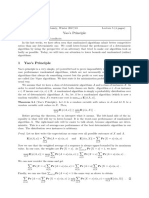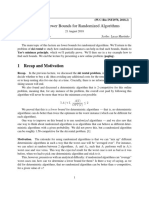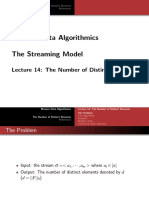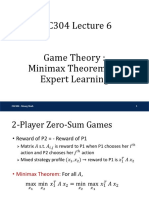Streaming Algorithm: Filtering & Counting Distinct Elements: Compsci 590.02 Instructor: Ashwinmachanavajjhala
Uploaded by
Mirza AbdullaStreaming Algorithm: Filtering & Counting Distinct Elements: Compsci 590.02 Instructor: Ashwinmachanavajjhala
Uploaded by
Mirza AbdullaStreaming Algorithm: Filtering &
Counting Distinct Elements
CompSci 590.02
Instructor: AshwinMachanavajjhala
Lecture 6 : 590.02 Spring 13 1
Streaming Databases
Continuous/Standing Queries:
Every time a new data item
enters the system,
(conceptually) re-evalutate the
answer to the query
Can’t hope to
process a query on
the entire data, but
only on a small
working set.
Lecture 6 : 590.02 Spring 13 2
Examples of Streaming Data
• Internet & Web traffic
– Search/browsing history of users: Want to predict which ads/content to
show the user based on their history.
Can’t look at the entire history at runtime
• Continuous Monitoring
– 6 million surveillance cameras in London
– Video feeds from these cameras must be processed in real time
• Weather monitoring
• …
Lecture 6 : 590.02 Spring 13 3
Processing Streams
• Summarization
– Maintain a small size sketch (or summary) of the stream
– Answering queries using the sketch
– E.g., random sample
– later in the course – AMS, count min sketch, etc
– Types of queries: # distinct elements, most frequent elements in the
stream, aggregates like sum, min, max, etc.
• Window Queries
– Queries over a recent k size window of the stream
– Types of queries: alert if there is a burst of traffic in the last 1 minute,
denial of service identification, alert if stock price > 100, etc.
Lecture 6 : 590.02 Spring 13 4
Streaming Algorithms
• Sampling
– We have already seen this.
• Filtering
– “… does the incoming email address appear in a
set of white listed addresses … ”
• Counting Distinct Elements
– “… how many unique users visit cnn.com …”
• Heavy Hitters
– “… news articles contributing to >1% of all traffic …”
• Online Aggregation
– “… Based on seeing 50% of the data the answer is in [25,35] …”
Lecture 6 : 590.02 Spring 13 5
Streaming Algorithms
• Sampling
– We have already seen this.
• Filtering
– “… does the incoming email address appear in a
set of white listed addresses … ”
This Class
• Counting Distinct Elements
– “… how many unique users visit cnn.com …”
• Heavy Hitters
– “… news articles contributing to >1% of all traffic …”
• Online Aggregation
– “… Based on seeing 50% of the data the answer is in [25,35] …”
Lecture 6 : 590.02 Spring 13 6
FILTERING
Lecture 6 : 590.02 Spring 13 7
Problem
• A set S containing m values
– A whitelist of a billion non-spam email addresses
• Memory with n bits.
– Say 1 GB memory
• Goal: Construct a data structure that can efficient check whether
a new element is in S
– Returns TRUE with probability 1, when element is in S
– Returns FALSE with high probability (1-ε), when element is not in S
Lecture 6 : 590.02 Spring 13 8
Bloom Filter
• Consider a set of hash functions {h1, h2, .., hk}, hi: S [1, n]
Initialization:
• Set all n bits in the memory to 0.
Insert a new element ‘a’:
• Compute h1(a), h2(a), …, hk(a). Set the corresponding bits to 1.
Check whether an element ‘a’ is in S:
• Compute h1(a), h2(a), …, hk(a).
If all the bits are 1, return TRUE.
Else, return FALSE
Lecture 6 : 590.02 Spring 13 9
Analysis
If a is in S:
• If h1(a), h2(a), …, hk(a) are all set to 1.
• Therefore, Bloom filter returns TRUE with probability 1.
If a not in S:
• Bloom filter returns TRUE if each hi(a) is 1 due to some other
element
Pr[bit j is 1 after m insertions] = 1 – Pr[bit j is 0 after m insertions]
= 1 – Pr[bit j was not set by k x m hash functions]
= 1 – (1 – 1/n)km
Pr[Bloom filter returns TRUE] = {1 – (1 – 1/n)km}k} ≈ (1 – e-km/n)k
Lecture 6 : 590.02 Spring 13 10
Example
• Suppose there are m = 109 emails in the white list.
• Suppose memory size of 1 GB (8 x 109 bits)
k=1
• Pr[Bloom filter returns TRUE | a not in S] = 1 – e-m/n
= 1 – e-1/8 = 0.1175
k=2
• Pr[Bloom filter returns TRUE | a not in S] = (1 – e-2m/n)2
= (1 – e-1/4)2 ≈ 0.0493
Lecture 6 : 590.02 Spring 13 11
Example
• Suppose there are m = 109 emails in the white list.
• Suppose memory size of 1 GB (8 x 109 bits)
False Positive Probability
Exercise:
What is the optimal number of
hash functions given m=|S| and n.
Number of hash functions
Lecture 6 : 590.02 Spring 13 12
Summary of Bloom Filters
• Given a large set of elements S, efficiently check whether a new
element is in the set.
• Bloom filters use hash functions to check membership
– If a is in S, return TRUE with probability 1
– If a is not in S, return FALSE with high probability
– False positive error depends on |S|, number of bits in the memory and
number of hash functions
Lecture 6 : 590.02 Spring 13 13
COUNTING DISTINCT ELEMENTS
Lecture 6 : 590.02 Spring 13 14
Distinct Elements
INPUT:
• A stream S of elements from a domain D
– A stream of logins to a website
– A stream of URLs browsed by a user
• Memory with n bits
OUTPUT
• An estimate of the number of distinct elements in the stream
– Number of distinct users logging in to the website
– Number of distinct URLs browsed by the user
Lecture 6 : 590.02 Spring 13 15
FM-sketch
• Consider a hash function h:D {0,1}L which uniformly hashes
elements in the stream to L bit values
• IDEA: The more distinct elements in S, the more distinct hash
values are observed.
• Define: Tail0(h(x)) = number of trailing consecutive 0’s
– Tail0(101001) = 0
– Tail0(101010) = 1
– Tail0(001100) = 2
– Tail0(101000) = 3
– Tail0(000000) = 6 (=L)
Lecture 6 : 590.02 Spring 13 16
FM-sketch
Algorithm
• For all x ε S,
– Compute k(x) = Tail0(h(x))
• Let K = max x ε S k(x)
• Return F’ = 2K
Lecture 6 : 590.02 Spring 13 17
Analysis
Lemma: Pr[ Tail0(h(x)) ≥ j ] = 2-j
Proof:
• Tail0(h(x)) ≥ j implies at least the last j bits are 0
• Since elements are hashed to L-bit string uniformly at random,
the probability is (½)j = 2-j
Lecture 6 : 590.02 Spring 13 18
Analysis
• Let F be the true count of distinct elements, and
let c>2 be some integer.
• Let k1 be the largest k such that 2k < cF
• Let k2 be the smallest k such that 2k > F/c
• If K (returned by FM-sketch) is between k2 and k1, then
F/c ≤ F’ ≤ cF
Lecture 6 : 590.02 Spring 13 19
Analysis
• Let zx(k) = 1 if Tail0(h(x)) ≥ k
= 0 otherwise
• E[zx(k)] = 2-k Var(zx(k)) = 2-k(1 – 2-k)
• Let X(k) = ΣxεS zx(k)
• We are done if we show with high probability that
X(k1) = 0 and X(k2) ≠ 0
Lecture 6 : 590.02 Spring 13 20
Analysis
Lemma: Pr[X(k1) ≥ 1] ≤ 1/c
Proof: Pr[X(k1) ≥ 1] ≤ E(X(k1)) Markov Inequality
= F 2-k1 ≤ 1/c
Lemma: Pr[X(k2) = 0] ≤ 1/c
Proof: Pr[X(k2) = 0] = Pr[X(k2) – E(X(k2)) = E(X(k2))]
≤ Pr[|X(k2) – E(X(k2))| ≥ E(X(k2))]
≤ Var(X(k2)) / E(X(k2))2 Chebyshev Ineq.
≤ 2k2/F ≤ 1/c
Theorem: If FM-sketch returns F’, then for all c > 2,
F/c ≤ F’ ≤ cF with probability 1-2/c
Lecture 6 : 590.02 Spring 13 21
Boosting the success probability
• Construct s independent FM-sketches (F’1, F’2, …, F’s)
• Return the median F’med
Q: For any δ, what is the value of s s.t. P[F/c ≤ F’med ≤ cF] > 1 - δ ?
Lecture 6 : 590.02 Spring 13 22
Analysis
• Let c > 4, and xi = 0 if F/c ≤ F’i ≤ cF, and 1 otherwise
• ρ = E[xi]
= 1 - Pr[F/c ≤ F’i ≤ cF] ≤ 2/c < ½
• Let X = Σi xi E(X) = sρ
Lemma: If X < s/2, then F/c ≤ F’med ≤ cF (Exercise)
We are done if we show that Pr[X ≥ s/2] is small.
Lecture 6 : 590.02 Spring 13 23
Analysis
Pr[ X ≥ s/2 ] = Pr[ X – E(X) = s/2 – E(X) ]
≤ Pr[ |X – E(X)| ≥ s/2 – sρ ]
= Pr[ |X – E(X)| ≥ (1/2ρ – 1) sρ ]
≤ 2exp( – (1/2ρ – 1)2 sρ/3 ) Chernoff bounds
Thus, to bound this probability by δ, we need s to be:
Lecture 6 : 590.02 Spring 13 24
Boosting the success probability
In practice,
• Construct sk independent FM sketches
• Divide the sketches into s groups of k each
• Compute the mean estimate in each group
• Return the median of the means.
Lecture 6 : 590.02 Spring 13 25
Summary
• Counting the number of distinct elements exactly takes O(N)
space and Ω(N) time, where N is the number of distinct elements
• FM-sketch estimates the number of distinct elements in O(log N)
space and Θ(N) time
• FM-sketch: maximum number of trailing 0s in any hash value
• Can get good estimates with high probability by computing the
median of many independent FM-sketches.
Lecture 6 : 590.02 Spring 13 26
You might also like
- Ranged Queries Using Bloom Filters FinalNo ratings yetRanged Queries Using Bloom Filters Final19 pages
- Unit Title: It's A Slippery Slope!: Project-Based Learning Unit PlanNo ratings yetUnit Title: It's A Slippery Slope!: Project-Based Learning Unit Plan9 pages
- Recursion: Breaking Down Problems Into Solvable SubproblemsNo ratings yetRecursion: Breaking Down Problems Into Solvable Subproblems26 pages
- 19.1. Partitioning-Based Clustering AlgorithmsNo ratings yet19.1. Partitioning-Based Clustering Algorithms27 pages
- Computer Vision: Spring 2006 15-385,-685No ratings yetComputer Vision: Spring 2006 15-385,-68558 pages
- Clustering Gene Expression Data: CS 838 WWW - Cs.wisc - Edu/ Craven/cs838.html Mark Craven Craven@biostat - Wisc.edu April 2001No ratings yetClustering Gene Expression Data: CS 838 WWW - Cs.wisc - Edu/ Craven/cs838.html Mark Craven Craven@biostat - Wisc.edu April 200112 pages
- Principal Components Analysis (PCA) in MatlabNo ratings yetPrincipal Components Analysis (PCA) in Matlab11 pages
- CS229 Final Report - Music Genre ClassificationNo ratings yetCS229 Final Report - Music Genre Classification6 pages
- Vorlesung02 Statistical Models in SimulationNo ratings yetVorlesung02 Statistical Models in Simulation42 pages
- A Fuzzy Self Constructing Feature Clustering Algorithm For Text ClassificationNo ratings yetA Fuzzy Self Constructing Feature Clustering Algorithm For Text Classification31 pages
- Computer Architecture and Organization: Lecture 6: Floating PointsNo ratings yetComputer Architecture and Organization: Lecture 6: Floating Points20 pages
- Applications of Dynamic Programming: Steven SkienaNo ratings yetApplications of Dynamic Programming: Steven Skiena20 pages
- Binary Search Algorithm: 14.1. IntuitionNo ratings yetBinary Search Algorithm: 14.1. Intuition3 pages
- 10-601 Machine Learning: Homework 7: InstructionsNo ratings yet10-601 Machine Learning: Homework 7: Instructions5 pages
- Optimum Global Thresholding Using Otsu's MethodNo ratings yetOptimum Global Thresholding Using Otsu's Method5 pages
- Topic 4 - Randomized Algorithms, II: 4.1.1 Clustering Via Graph CutsNo ratings yetTopic 4 - Randomized Algorithms, II: 4.1.1 Clustering Via Graph Cuts6 pages
- EC 2214: Coding & Data Compression: Vishwakarma Institute of TechnologyNo ratings yetEC 2214: Coding & Data Compression: Vishwakarma Institute of Technology35 pages
- Random Number Generation: Dr. John Mellor-CrummeyNo ratings yetRandom Number Generation: Dr. John Mellor-Crummey30 pages
- Accelerated Data Science Introduction To Machine Learning AlgorithmsNo ratings yetAccelerated Data Science Introduction To Machine Learning Algorithms37 pages
- Compsci Algorithms For Data Science: Cameron Musco University of Massachusetts Amherst. Fall 2019No ratings yetCompsci Algorithms For Data Science: Cameron Musco University of Massachusetts Amherst. Fall 201928 pages
- K-Means Algorithm: Clustering Methods: Part 2aNo ratings yetK-Means Algorithm: Clustering Methods: Part 2a10 pages
- Clustering: Unsupervised Learning Methods 15-381No ratings yetClustering: Unsupervised Learning Methods 15-38125 pages
- Power & Energy Signals Questions and Answers - SanfoundryNo ratings yetPower & Energy Signals Questions and Answers - Sanfoundry11 pages
- Analysis of Algorithms: CS 302 - Data Structures Section 2.6No ratings yetAnalysis of Algorithms: CS 302 - Data Structures Section 2.648 pages
- Digital Signal and Image Processing using MATLAB, Volume 3: Advances and Applications, The Stochastic CaseFrom EverandDigital Signal and Image Processing using MATLAB, Volume 3: Advances and Applications, The Stochastic Case3/5 (1)
- A Brief Introduction to MATLAB: Taken From the Book "MATLAB for Beginners: A Gentle Approach"From EverandA Brief Introduction to MATLAB: Taken From the Book "MATLAB for Beginners: A Gentle Approach"2.5/5 (2)
- Moments and Deviations: 3.1. Markov's InequalityNo ratings yetMoments and Deviations: 3.1. Markov's Inequality27 pages
- 1 Minimum Spanning Tree (MST) : Lecture Notes CS:5360 Randomized AlgorithmsNo ratings yet1 Minimum Spanning Tree (MST) : Lecture Notes CS:5360 Randomized Algorithms9 pages
- 5.2.2. Application: Bucket Sort: 12-Feb-15 Mat-72306 Randal, Spring 2015 207No ratings yet5.2.2. Application: Bucket Sort: 12-Feb-15 Mat-72306 Randal, Spring 2015 20726 pages
- Proof: Applying Markov's Inequality, For Any: 0 PR (1 +) PRNo ratings yetProof: Applying Markov's Inequality, For Any: 0 PR (1 +) PR19 pages
- Randomized Algorithms: Prof. Tapio ElomaaNo ratings yetRandomized Algorithms: Prof. Tapio Elomaa37 pages
- 1 Markov's Inequality: Lecture Notes CS:5360 Randomized AlgorithmsNo ratings yet1 Markov's Inequality: Lecture Notes CS:5360 Randomized Algorithms11 pages
- 1 What Is A Randomized Algorithm?: Lecture Notes CS:5360 Randomized AlgorithmsNo ratings yet1 What Is A Randomized Algorithm?: Lecture Notes CS:5360 Randomized Algorithms8 pages
- Lower Bound On Deterministic Evaluation Algorithms For NOR Circuits - Yao's Principle For Proving Lower BoundsNo ratings yetLower Bound On Deterministic Evaluation Algorithms For NOR Circuits - Yao's Principle For Proving Lower Bounds61 pages
- Yao's Minimax Principle: Game Tree EvaluationNo ratings yetYao's Minimax Principle: Game Tree Evaluation30 pages
- Lecture 2: Lower Bounds For Randomized AlgorithmsNo ratings yetLecture 2: Lower Bounds For Randomized Algorithms10 pages
- (Said S.E.H. Elnashaie, Parag Garhyan) ConservatioNo ratings yet(Said S.E.H. Elnashaie, Parag Garhyan) Conservatio661 pages
- Activity Analysis, Cost Behavior, and Cost Estimation: Answers To Review QuestionsNo ratings yetActivity Analysis, Cost Behavior, and Cost Estimation: Answers To Review Questions84 pages
- Algorithm Design by Kleinberg and Tardos The Art of Computer Programming by Donald Knuth How To Solve It by Computer by R. G. DromeyNo ratings yetAlgorithm Design by Kleinberg and Tardos The Art of Computer Programming by Donald Knuth How To Solve It by Computer by R. G. Dromey2 pages
- 5.60 Thermodynamics & Kinetics: Mit OpencoursewareNo ratings yet5.60 Thermodynamics & Kinetics: Mit Opencourseware6 pages
- Exam Prep 4 Solutions: Q1. MDPS: Dice BonanzaNo ratings yetExam Prep 4 Solutions: Q1. MDPS: Dice Bonanza4 pages
- Examples of Markov Chains: - Random Walk On A LineNo ratings yetExamples of Markov Chains: - Random Walk On A Line23 pages
- G Saxby Practical - Holography - Chapter 1 - What Is A HologramNo ratings yetG Saxby Practical - Holography - Chapter 1 - What Is A Hologram13 pages
- Bathtub Dynamics: Initial Results of A Systems Thinking InventoryNo ratings yetBathtub Dynamics: Initial Results of A Systems Thinking Inventory53 pages
- Unit Title: It's A Slippery Slope!: Project-Based Learning Unit PlanUnit Title: It's A Slippery Slope!: Project-Based Learning Unit Plan
- Recursion: Breaking Down Problems Into Solvable SubproblemsRecursion: Breaking Down Problems Into Solvable Subproblems
- Clustering Gene Expression Data: CS 838 WWW - Cs.wisc - Edu/ Craven/cs838.html Mark Craven Craven@biostat - Wisc.edu April 2001Clustering Gene Expression Data: CS 838 WWW - Cs.wisc - Edu/ Craven/cs838.html Mark Craven Craven@biostat - Wisc.edu April 2001
- A Fuzzy Self Constructing Feature Clustering Algorithm For Text ClassificationA Fuzzy Self Constructing Feature Clustering Algorithm For Text Classification
- Computer Architecture and Organization: Lecture 6: Floating PointsComputer Architecture and Organization: Lecture 6: Floating Points
- Applications of Dynamic Programming: Steven SkienaApplications of Dynamic Programming: Steven Skiena
- Topic 4 - Randomized Algorithms, II: 4.1.1 Clustering Via Graph CutsTopic 4 - Randomized Algorithms, II: 4.1.1 Clustering Via Graph Cuts
- EC 2214: Coding & Data Compression: Vishwakarma Institute of TechnologyEC 2214: Coding & Data Compression: Vishwakarma Institute of Technology
- Accelerated Data Science Introduction To Machine Learning AlgorithmsAccelerated Data Science Introduction To Machine Learning Algorithms
- Compsci Algorithms For Data Science: Cameron Musco University of Massachusetts Amherst. Fall 2019Compsci Algorithms For Data Science: Cameron Musco University of Massachusetts Amherst. Fall 2019
- Power & Energy Signals Questions and Answers - SanfoundryPower & Energy Signals Questions and Answers - Sanfoundry
- Analysis of Algorithms: CS 302 - Data Structures Section 2.6Analysis of Algorithms: CS 302 - Data Structures Section 2.6
- Digital Signal and Image Processing using MATLAB, Volume 3: Advances and Applications, The Stochastic CaseFrom EverandDigital Signal and Image Processing using MATLAB, Volume 3: Advances and Applications, The Stochastic Case
- A Brief Introduction to MATLAB: Taken From the Book "MATLAB for Beginners: A Gentle Approach"From EverandA Brief Introduction to MATLAB: Taken From the Book "MATLAB for Beginners: A Gentle Approach"
- 1 Minimum Spanning Tree (MST) : Lecture Notes CS:5360 Randomized Algorithms1 Minimum Spanning Tree (MST) : Lecture Notes CS:5360 Randomized Algorithms
- 5.2.2. Application: Bucket Sort: 12-Feb-15 Mat-72306 Randal, Spring 2015 2075.2.2. Application: Bucket Sort: 12-Feb-15 Mat-72306 Randal, Spring 2015 207
- Proof: Applying Markov's Inequality, For Any: 0 PR (1 +) PRProof: Applying Markov's Inequality, For Any: 0 PR (1 +) PR
- 1 Markov's Inequality: Lecture Notes CS:5360 Randomized Algorithms1 Markov's Inequality: Lecture Notes CS:5360 Randomized Algorithms
- 1 What Is A Randomized Algorithm?: Lecture Notes CS:5360 Randomized Algorithms1 What Is A Randomized Algorithm?: Lecture Notes CS:5360 Randomized Algorithms
- Lower Bound On Deterministic Evaluation Algorithms For NOR Circuits - Yao's Principle For Proving Lower BoundsLower Bound On Deterministic Evaluation Algorithms For NOR Circuits - Yao's Principle For Proving Lower Bounds
- (Said S.E.H. Elnashaie, Parag Garhyan) Conservatio(Said S.E.H. Elnashaie, Parag Garhyan) Conservatio
- Activity Analysis, Cost Behavior, and Cost Estimation: Answers To Review QuestionsActivity Analysis, Cost Behavior, and Cost Estimation: Answers To Review Questions
- Algorithm Design by Kleinberg and Tardos The Art of Computer Programming by Donald Knuth How To Solve It by Computer by R. G. DromeyAlgorithm Design by Kleinberg and Tardos The Art of Computer Programming by Donald Knuth How To Solve It by Computer by R. G. Dromey
- 5.60 Thermodynamics & Kinetics: Mit Opencourseware5.60 Thermodynamics & Kinetics: Mit Opencourseware
- Examples of Markov Chains: - Random Walk On A LineExamples of Markov Chains: - Random Walk On A Line
- G Saxby Practical - Holography - Chapter 1 - What Is A HologramG Saxby Practical - Holography - Chapter 1 - What Is A Hologram
- Bathtub Dynamics: Initial Results of A Systems Thinking InventoryBathtub Dynamics: Initial Results of A Systems Thinking Inventory

















